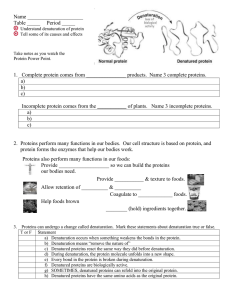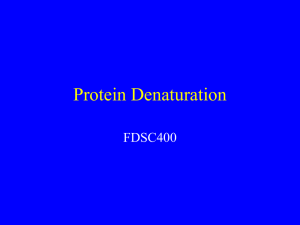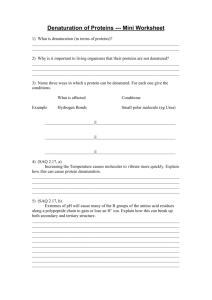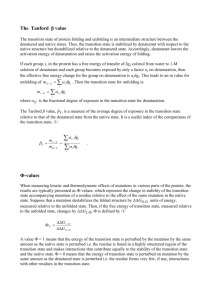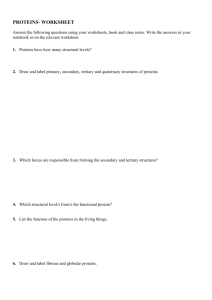7.88 Lecture Notes - 9 7.24/7.88J/5.48J The Protein Folding and Human Disease
advertisement
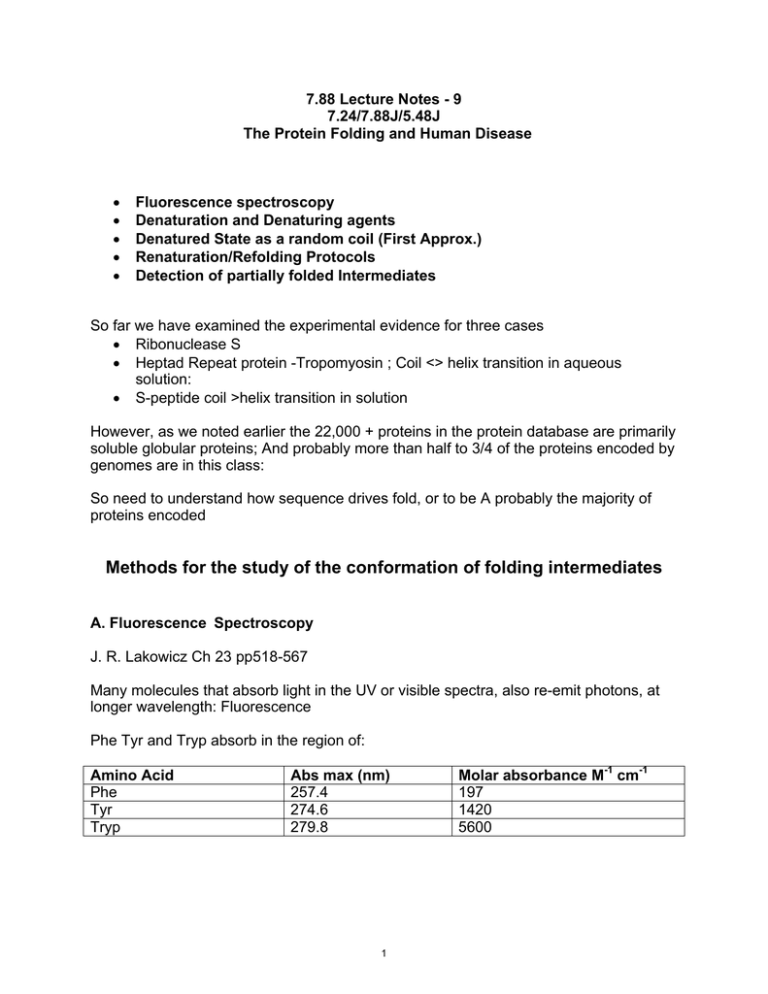
7.88 Lecture Notes - 9
7.24/7.88J/5.48J
The Protein Folding and Human Disease
•
•
•
•
•
Fluorescence spectroscopy
Denaturation and Denaturing agents
Denatured State as a random coil (First Approx.)
Renaturation/Refolding Protocols
Detection of partially folded Intermediates
So far we have examined the experimental evidence for three cases
• Ribonuclease S
• Heptad Repeat protein -Tropomyosin ; Coil <> helix transition in aqueous
solution:
• S-peptide coil >helix transition in solution
However, as we noted earlier the 22,000 + proteins in the protein database are primarily
soluble globular proteins; And probably more than half to 3/4 of the proteins encoded by
genomes are in this class:
So need to understand how sequence drives fold, or to be A probably the majority of
proteins encoded
Methods for the study of the conformation of folding intermediates
A. Fluorescence Spectroscopy
J. R. Lakowicz Ch 23 pp518-567
Many molecules that absorb light in the UV or visible spectra, also re-emit photons, at
longer wavelength: Fluorescence
Phe Tyr and Tryp absorb in the region of:
Amino Acid
Phe
Tyr
Tryp
Abs max (nm)
257.4
274.6
279.8
1
Molar absorbance M-1 cm-1
197
1420
5600
Absorbance A =log10(Io/I):
Io is transmittance by reference solution, I is transmittance by sample.
Molar absorbance is = A/bc, where b is path length in centimeters, and c is
concentration in moles/liter
280mu. Phe peak is about 255 but 1/20 that of tryp peak at 280.
Absorption in this region of the spectrum is due to changes in electronic energy levels,
levels of orbital electrons.
Photon absorption occurs in 10(-15) seconds, so short that nucleus doesn't change
much in time interval; so goes up in energy level almost instantaneously , but lifetime is
much longer, 10(-8) seconds.
Return to ground state usually multi-step:
• small losses of energy in atomic collisions >> Goes back to lowest vibrational
energy level state of excited electronic state (faster than emission);
If molecule doesn't blow up, then after short period of time,
• returns to lowest energy level emitting a photon; since excited state has lost a
little energy, then photon emitted will be lower energy, longer wavelength than
photon absorbed;
Lambda max for fluorescence:
Phe
282
0.04
Tyr
303
0.21
Tryp
340
0.20
Emission occurs on nanosecond time scale; Process occurs like radioactive decay I =
Ioe (-t/g), where t is time after end of light, g is average lifetime of fluorescent state;
Because emission is a property of valence electrons, sensitive to environment;
Fluorescence; tryptophane: in water 350; buried in proteins 330.
Native florescent spectrum
Denatured fluorescent spectrum:
2
B. Denaturation and the Denatured State
These studies were carried on purified chains refolding in vitro; of course in cell s chains
released from ribosomes, but some 20 years passed before it was possible to study
protein folding intermediates in vivo:
Now let’s consider studying this problem for a complete polypeptide chain of a globular
protein in the general case, for example globin with its 7 helices; to examine the folding
pathway for the globin chain in the test tube, we would need unfolded molecules;
We also need to reach the unfolded or partially unfolded state to recover active forms of
incorrectly or misfolded molecules; Eli Lilly manufactures human insulin by expressing
the cloned gene in E. coli. When they harvest the cells the insulin chains accumulate as
an insoluble mass called an “inclusion body”. In order to obtain biologically active
insulin the chains must be solubilized and then refolded in vitro.
It turns out that maintaining an unfolded state of biologically evolved polypeptide chains is not trivial
In order to investigate how chains reach their native state, need access to some defined
unfolded –denatured state.
In order to recover correctly folded forms of incorrectly folded or misfolded proteins, also
need denatured state
Practical;
To maintain proteins active, need to understand processes of denaturation.
To recover proteins from denatured states, need some knowledge thereof. IN fact
general result of cloning gene into expression vector, is generation of non native
aggregated state called an inclusion body:
Obtaining native protein requires successfully refolding in vitro;
• Requires access to soluble state
• Method to study basis of stability of native conformation.
• To study folding pathway, need defined unfolded starting state.
Denaturation; Process of the loss of nature structure: associated with unusual phase
transition associated with structure loss: upon mild treatment:
The denatured state is usually identified by the
• Loss of biological functions
o Loss of catalytic activity
o Loss of ligand binding properties
o Loss of antibody recognition: and
• Change in solution properties
o Increased viscosity
o Aggregates large enough to scatter light
o Change in spectroscopic properties.
3
Under conditions in which Covalent modification not detectable - The term denatured
refers to an operation: it’s the description of a state in terms of having passed through
operation.
Denaturing Agents:
Globular proteins can be denatured with a wide variety of agents:
•
Heat
o Denatured chains usually partially structured and aggregated (treatment
with additional denaturing agents causes further changes).
o Often not reversible on cooling outside very narrow set of conditions.
o Covalent side reactions as temperature increases.
Tropomyosin is an exception!
•
pH
o
o
o
o
•
Ionization of side chains breaking ion pairs, salt bridges
Denatured chains highly charged:
Increased charge density leads generalized electrostatic repulsion;
Unfolded chain is structured
Organic solvents
o Benzene
o Phenol
o Trichloroethylene
o Acetone
o Ethanol
o Chloroform
o Acetonitrile
-
•
Often neither native nor denatured state soluble in these solvents
Difficult to compare conformations between immiscible solvents
Some induce alpha-helicity, like TFE
Detergents
o sodium dodecyl sulfate
-
Enormously important for analysis; denatured state binds
1.4gm/gram of detergent - denatured state is highly structured:
-
Often is micellar form that is strongly denaturing; so detergent must
be above cmc, critical micelle concentration;
-
Difficult to remove detergents rapidly and efficiently
4
•
Certain inorganic salts
o Lithium bromide
o Sodium bromide
o potassium thiocynate (KSCN)
-
However, not general ionic strength, NaCl, KCl don't do it.
Ammonium sulfate is stabilizing
•
High Pressure
o Useful for multimeric proteins; dissociation reaction
•
Organic solutes
o Urea
NH2 - C=0 - NH2
-
Not an electrolyte: effects sensitive to pH and ionic strength
o Guanidinium Hydrochloride
NH2 - C = (NH2+Cl-) - NH2
-
Strong electrolyte. So denaturation always coupled with high ionic
strength
Experimental work on protein unfolding as a pre-condition for establishing an unfolding
refolding equilibrium is dominated by two reagents;
C. What is the State of these Denatured Molecules?
In both of these solvents -urea and GuHCL - a wide variety of proteins are denatured to
species that approximate very closely to random coils. For example, for a true random
coil, whose end to end to distance or radius of gyration is described by:
Sensitive measure of molecular volume is viscosity; unfolded chains occupy larger
volume than folded, and so interfere with fluid flow, increasing viscosity; Viscosity is a
measure of work done to produce a given rate of liquid flow; represents resistance to
liquid flow;
Add solute, viscosity generally increases.
When protein denatures, interaction –binding- surface with solvent increases sharply,
>> viscosity increases;
Intrinsic viscosities of native and GuHCl (5.0 -7.5M) denatured reduced chains(b-MeTh)
–25
5
Protein MW
RNase
Lysozyme
Hemoglobin
beta lactoglobulin
tropomysosin
13,700
14,300
64,500
36,800
76,000
Native
3.3
2.7
3.6
3.4
45
Denatured/Reduced
16.6 9.4
17.1 6.5
18.9
22.8 19.8
33
For a truly random coil, intrinsic viscosity is directly related to molecular weight through
an equation of the general form
[Have to extrapolate to zero shear to make sure molecules aren't orienting in solution.]
etaMo = Anb
Where Mo is the mean molecular weight of the amino acid residues;
n = number of residues
Finding of a straight line relating log of etaMo to log of Anb Determination of viscosity
versus molecular weight after denaturation is good evidence for a random coil
conformation in the resulting chains
C. Tanford, K. Kawaharas, and S. Laopanje (1967)
Proteins as Radnom Coils. I. Intrinsic viscosities and sedimentation coefficients in
concentrated guanidine hydrochloride JACS 89 729.
For GuHCl Tanford found A = 77.3, b =0.666
If plot logarithmically log {viscosity] M versus logn [n] get linear relationship
Here is data from Charles Tanford on the linear variation of intrinsic viscosity as a
function of chain length for polypeptide chains in high concentrations (5 - 7.5 M GuHCl)
at 25°C.
log[eta]Mo
log n
A similar result is obtained with the same proteins in 8M urea, with very small
differences in parameters, A =76, b =0.655.
One care need to take with urea, at neutral and alkaline pH decomposes slowly to form
cyanate ion. This reacts with free amino groups to form carbamyl derivatives.
6
D. An Equilibrium Denaturation Experiment
Native protein in buffer: dilute to increasing concentrations of urea: examine properties;
for example enzyme activity and fluorescence quenching of tryptophanes
Incubate until no further changes:
Cautions: urea decomposes to reactive cyanates; watch out for metals contamination:
need to re-crystallize ultra-pure stuff;
In folded state, prolyl peptide bonds stabilized by folded structure; in unfolded state,
isomerization proceeds in solution; very slow; at equilibrium cis trans prolyl peptide
bonds different than in first few minutes after unfolding:
The general nature of the denaturation process, somewhat independent of method is
that it is usually highly cooperative, showing a steep change in the state with the
variable. Looks like sloppy phase transition;
That is, the molecules are either native or denatured, with limited evidence of
intermediates. Thus in the transition state have mixture of native and denatured. Like
phase change.
The Mechanism of Urea and Guanidinium Denaturation:
Large literature on action of GdHCl on proteins, but still no mechanism. This is flip side
of the very limited ability to assess what is holding the protein together - high
concentrations necessary Organic solutes Strong electrolyte. So denaturation always coupled with high ionic strength for
denaturation, for example 6M, these reagents are occupying roughly half the solvent
volume. General notion is that they are acting changing the structure of water.
Two studies that give some notion of what is going on:
Hibbard and Tulinsky Biochemistry 17, 5460-5468. Equilibrated crystal of alphachymotrypsin with 2MGuHCl or with 3M urea and examined diffraction pattern.
Obviously this is below denaturation transition, but approaching it.
GDHCl disrupted primarily surface of molecules in crystal. Solvent becomes better
solvent for surface chains.
Urea appeared to diffuse into molecule; perhaps solvates non-polar groups otherwise
buried. non-polar M.
What about proteins lacking disulfide bonds:
7
E. Criteria for existence of partially folded intermediates
During equilibrium unfolding and refolding experiments:
Protein diluted into various concentrations of denaturant: incubated until no change in
signal; (determine empirically)
Renaturation: Fully denatured protein diluted back to increasing concentrations of
buffer; samples it until no further change in signal;
In reading for Thursday you will see that time this sample has incubated in denaturant is
a critical variable in refolding kinetics”
1. Complex Equilibrium denaturation
Here is equilibrium denaturation/renaturation experiment:
If curve has a break in slope, normally interpreted as due to presence of a
partially folded intermediate at intermediate denaturant concentrations: This is
data for
In the middle of the transition at last three species populated to some extent, U, I,
and N
2. Non coincidence of signals
Here is denaturation curve for a protein, in which experimenters following two
different signals: fluorescence and circular dichroism;
Fluorescence groups being exposed to solvent at lower GdHCl concentration that
overall backbone unfolding:
Suggests that partially folded species formed, with region around tryp disordered,
but most of protein intact:
3. Occasionally see third class of curves
Here is one for RNase T from Pace et al RNase T: fluorescence increases, then
decreases; Can have other kinds of curves
Now of the utmost importance to distinguish kinetic experiments - initiate reaction
follow course, under conditions that back reaction not significant, and equilibrium
experiment, in which ignore pathway, examine only distribution of end states:
In a kinetic experiment evidence for more than two states would come from
presence of more than one kinetic phase:
• If only one transition, U >>N, then expect single rate process:
• If in studying kinetics observe complex kinetics, for example:
8
-
Initial fast rate followed by slow rate followed by much slower rate,
evidence that more than one process going on, must be at least
one other species present;
Let’s review point about intermediates:
If only two states, then fluorescence either 2 (native) or 1 (quenched) (tryp 59)
Lets say monitor some other signal, CD alpha helicity: value is 2 or 5; Then both curves
will of necessity have same shape; all values simply sum of two populations:
If partially folded intermediate, its properties could differ from N and U: Its tryp could be
buried, as in N (f=2), but its helices only partially formed - say CD value three:
Then CD curve would differ from fluorescence curve:
Then as proceed through folding transition, these values follow distribution of
partitioning;
Part C
9
MIT OpenCourseWare
http://ocw.mit.edu
7.88J / 5.48J / 10.543J Protein Folding and Human Disease
Spring 2015
For information about citing these materials or our Terms of Use, visit: http://ocw.mit.edu/terms.

